|

from
Swanson Website
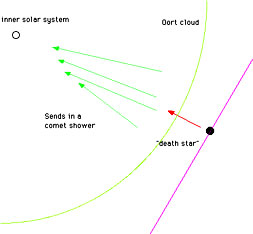
-
The Nemesis Theory which was originally published in "Nature" by
Davis, Hut and Muller, was appropriately named after the Greek
Goddess of retribution. "She whom none can escape."
(Yarris 1987)
-
It
offers an explanation for the seemingly periodicity of mass
extinctions that have occurred throughout the history of the earth.
It has been shown with the fossil record that mass extinctions have
occurred on average, a cycle of every 26 to 34 million years.
According to this theory, the sun has a companion star called the
Nemesis, which agitates the Oort cloud as it orbits around the sun.
(Goldsmith 1985)
-
The Oort cloud is a comet belt that orbits the sun;
extending tens of thousands A.U ( the distance from the earth to the
sun).
(Yarris 1987)
-
The gravitational field of the Nemesis causes
some comets to stray from heir normally stable orbit.
(Goldsmith)
-
These comets would hit the earth; causing varying levels of global
extinction with such devastating effects such as acid rain, deep
freeze, and ozone loss.
(Grossman 2001) (Morris 2001)
-
These comet
showers would last anywhere from 100,000 years to 2 million years
with approximately 10 impacts occurring in intervals of 50,000 years
between each impact.
(Yarris 1987)
-
The Nemesis Theory stems from the discovery of a crater 10 km in
diameter which is believed to have caused the extinction of the
dinosaurs 65 million years ago.
(Muller 2001)
-
This period of
extinction resulted in the death of 95% of all living creatures.
(Yarris
1987)
Evidence
Supporting the Nemesis Theory
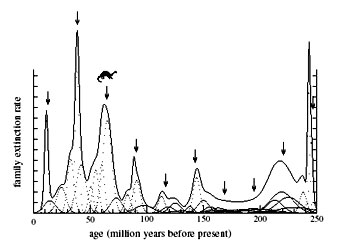
For one to first consider the Nemesis Theory, one must first accept
the notion that mass extinctions have occurred periodically.
-
By
examining the fossil record of marine fossils, Dave Raup and
Jack Sepkoski have gathered data showing the statistical estimation of
extinction as shown in the picture on the right. The arrows are
plotted every 26 million years and as one can see, they correlate
for the most part to the peaks of extinction. The dinosaur icon
refers to the end of the "Age of Reptiles." This graph displays a
periodicity of extinction, essential to the Nemesis Theory. This
regularity of extinction has also been shown to exist from data
collected from fossil genera of Raup and Sepkoski.
(Muller 2001)
-
Evidence for the Nemesis Theory can also be found with the discovery
of high concentrations of iridium which is only found in
extraterrestrial objects such as comets.
(Morris 2001)
-
These traces
of iridium can be found in samples of limestone at more than 25
sites around the world. They provide a geological history of the end
of the Cretaceous and the beginning of the Tertiary Period, which
marks the extinction of the dinosaurs.
(Yarris 1987)
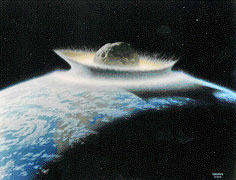
-
Between the
limestone of these two periods which is known as the K/T boundary,
is found a layer of red clay. When tested, this layer of clay was
found to be 600 times richer in iridium than that of the surrounding
limestone layers. It has been shown that the iridium found at the 25
different sites come from the same source. By measuring the
concentration of elements that are usually found with iridium such
as gold and platinum, it can be determined through a comparison of
the ratio of the elements that the iridium is a result from one
unifying source such as a comet.
(Goldsmith 1985)
-
With a further contemplation of the iridium data collected from the
limestone, it has been deduced that the presence of iridium was a
result of a collision of a comet with a 6 mile diameter, with the
earth.
(Morris 2001)
-
An impact of such magnitude, would cause fine
dust particles to rise into the stratosphere; blackening the sky and
leaving the world in perpetual darkness.
(Yarris 1987)
These
conditions would create an uninhabitable environment and therefore
the extinction of living creatures.
Another line of evidence not based on terrestrial effects, is found
by cosmic ray exposure. Meteorites created by comets have been shown
through cosmic ray exposure to have fallen to earth at approximately
during the same time of the last three extinctions. Cosmic ray
exposure is determined by measuring certain types of isotopes, such
as Neon 21 in meteorite samples.
-
It is used to discover the time
since formation, the meteorite spent orbiting the solar system. The
meteorites that would indicate an impact of a comet would be a high-
iron or "H chrondites" which receive their high- iron content from
the iron rich cores of asteroid or planets that were blasted by
collisions with comets. A correlation of these "H chrondites" have
been found with the occurrences of mass extinctions; giving further
evidence of the Nemesis Theory.
(Yarris 1987)
-
With the discovery of paleomagnetism, the reversals of earth's
magnetic field another piece of evidence was added to the Nemesis
Theory.
(Morris 2000)
-
It was hypothesized that when a comet hit the
earth, water near the equator due to extreme temperatures,
evaporated and turned into ice and snow on polar caps. Due to
conservation of angular momentum, a redistribution of mass would be
a great enough agitation to alter the magnetic field. These
geomagnetic reversals, through the research of Dave Raup to have
occurred 296 times and approximately every 30 million years;
correlating with the theory of the death star.
(Yarris 1987)
-
A drop in sea level which would result from a bolide impact would
also occur. This has been shown to exist at the K/T boundary.
(Yarris
1987)
The probability of a companion star also gains support by the fact
that more than 50% of stars in a galaxy are in a binary system,
which would lead one to conclude that a "death" companion star to
the sun to be a probable reality.
Rival Hypotheses
-
Volcanoes were first though of as an explanation for the mass
extinctions that have occurred throughout earth's history, however
they do not explain the periodicity of extinction periods. They also
do no explain the existence of high concentrations of iridium.
(Yarris
1987)
-
Meteorites could also account for extinction, yet due to the
randomness of their nature, they can not explain the recurring
cycles of extinction either.
(Goldsmith 1985)
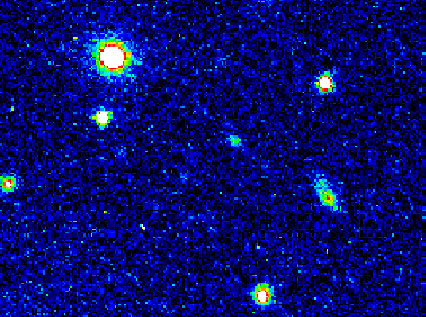
-
With an acceptance of the bolide impacts originating from the Oort
cloud, varying sources of gravitational pull that would result in a
comet shower also arise. Molecular dust clouds found in the Milky
Way were considered, yet the dust clouds would be too thinly
dispersed to cause enough gravitational force. Another source comes
from a hypothesized 10th planet called "Planet X". This theory
however would require an inner disk in the Oort cloud which could
not remain stable.
(Yarris 1987)
Arguments Against the Nemesis Theory
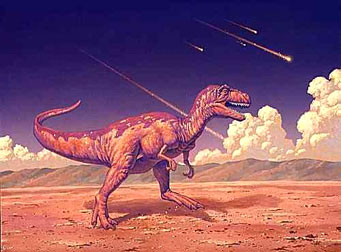
-
Some argue that the extinction of the dinosaurs would not happen in
1 to 2 years, yet would occur gradually with the decline of species
and would use this information as a negation of the Nemesis Theory.
However the Nemesis Theory does not require an immediate extinction
of life, for some forms of life could have survived the first the
impact and later be killed by another impact that would hit at later
time.
(Goldsmith 1985)
-
Others argue that the proposed elliptical orbit of the Nemesis star
would not be able to be maintained and that the companion star would
have long left our solar system. Yet the developers of the Nemesis
theory state that the orbit is not constant with time and that the
orbit was once closer to that of the sun. Objects such as passing
stars would have; through their gravitational field, caused the
orbit of the Nemesis to become larger and less stable.
(Muller 2001)
-
Also because the Nemesis Theory is not precise; extinctions
occurring within a range of 26 to 30 million years, that the theory
is invalid.
(Muller 2001)
-
However, this apparent problem in the
theory can be explained by passing stars which would cause a
deviation in the orbit of the death star, resulting in a change of a
few million years, without disrupting its orbit.
(Goldsmith 1985)
The Search for Nemesis
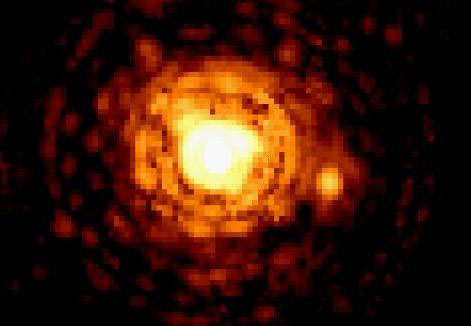
-
The ultimate evidence, supporting the
Nemesis Theory, would of
course be the actual discovery of the Nemesis star. It is predicted
that the Nemesis is probably a red dwarf star with a magnitude
between 7 and 12. Its size is believed to be a third of the sun's
and 1/1000 as bright.
(Yarris 1987)
-
It is thought that the Nemesis
star is right under our noses; being able to be seen with a pair of
binoculars. The reason it has not been discovered is that though all
stars have been catalogued, only a few of their distances have been
measured; making it difficult for scientists to pin point which star
could be the Nemesis.
(Muller 2001)
-
The search for the Nemesis in underway at the
Leuschner Observatory
in Layfette California with an automated telescope. To determine
which star is the Sun's companion star, photographs of 5,000 red
stars have been taken along with the measurement of the apparent
shift in position determined by a second photograph picture taken 2
to 6 months later. A little change in position indicate that the
stars are far away. However, stars that are close enough to possibly
be the Nemesis will show a significant shift in position.
(Muller
2001)
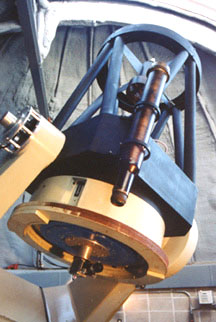
-
It is guessed that the Nemesis star will be discovered in
the
Hydra constellation.
(Yarris 1987)
Conclusion
It has been shown through evidence such as iridium, that comets are
the probable cause for the mass extinction that have occurred on
Earth. This information coupled with the evidence for the
periodicity of mass extinctions, give validity to the Nemesis Theory
which should lead to its greater acceptance. Hopefully however,
future generations of humans will not be around to see the
actualization of the theory into law.
References
-
Goldsmith, Donald. Nemesis. New York: Walker and Company, 1985.
-
Grossman, Daniel. "One Disaster After Another." Scientific American.
Feb. 2001
-
Morris, Mark. , et al. GE70A; Origin and Evolution of the Cosmos and
Life. Course Reader Material, 2000
-
Morris, Mark. , et al. GE70B; Origin and Evolution of the Cosmos and
Life. Course Reader Material, 2001
-
Muller, Richard. "Nemesis."
-
Yarris, Lynn. "Does a Companion Star to the Sun Cause Earth's
Periodic Mass Extinctions?" Science Beat. Spring 1987
|







